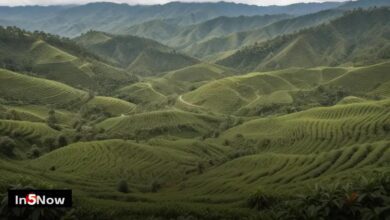What Makes Coffee Beans From Different Regions Unique?

Coffee beans from different regions possess unique characteristics due to factors like terroir, climate, and processing methods. African coffees often feature bright acidity and fruity flavors, while those from Central America exhibit balanced sweetness, allowing coffee enthusiasts to enjoy a diverse range of tasting notes.
What makes coffee beans from different regions unique? From the mountains of Ethiopia to the lush landscapes of Colombia, each cup tells a story. The origin of coffee beans plays a crucial role in shaping their flavor, aroma, and overall experience. In this article, we’ll delve into how factors like climate, soil, and processing methods contribute to the diverse flavors found in coffee.
Understanding Coffee Terroir
Understanding coffee terroir is crucial for appreciating the unique flavors of coffee beans. Terroir refers to the environmental factors that affect a crop’s phenotype, including soil composition, climate, and altitude. Each coffee-growing region has its own distinct terroir, which influences the taste and aroma of the beans.
Soil Composition
The type of soil in which coffee is grown can greatly impact its flavor profile. For instance, volcanic soils are rich in minerals and can lend a vibrant acidity to the beans, while clay or sandy soils may impart different characteristics. Understanding these soil types helps in discerning the complex flavor notes in each cup of coffee.
Climate and Weather
Climate plays a vital role in determining the characteristics of coffee beans. Regions with cooler temperatures and adequate rainfall typically produce higher quality coffee. Variations in climate, such as humidity and sunlight exposure, lead to different growth rates and flavor developments in coffee cherries.
Altitude Effects
The altitude at which coffee is grown also contributes to flavor diversity. Higher elevations often yield denser beans that have more pronounced flavors and acidity. Specialty coffees from regions like Colombia and Ethiopia are frequently grown at altitudes exceeding 1,200 meters, resulting in unique taste experiences.
In summary, understanding coffee terroir allows us to appreciate the rich, complex flavors and aromas unique to each region. It is a fascinating journey through the interplay of nature and cultivation that brings each cup of coffee to life.
Unique Coffee Bean Flavors by Region
Unique coffee bean flavors by region highlight the diversity of tastes that coffee lovers can experience. Each coffee-producing region around the world has its own specific growing conditions, which contribute to the unique flavor profiles of their beans.
African Coffees
African coffees, such as those from Ethiopia and Kenya, are known for their bright acidity and fruity flavors. Ethiopian coffees often have floral notes and fruitiness, while Kenyan beans can exhibit strong berry and citrus characteristics.
Central and South American Coffees
Central and South American coffees tend to be well-balanced with a medium body. For instance, Colombian coffee is praised for its sweetness and nutty flavors, while Guatemalan beans often have a chocolatey profile, combined with a nice acidity.
Asian Coffees
Asian coffees, including those from Indonesia and Vietnam, bring an entirely different set of flavors to the table. Indonesian coffees, for example, are often full-bodied with earthy and spicy notes. Vietnamese coffee, typically made using robusta beans, tends to be strong and has a distinctive bittersweet taste.
In summary, the geographic origin of coffee beans significantly shapes their flavors. Understanding these unique profiles allows coffee enthusiasts to enjoy a journey through the distinct tastes of different regions.
The Importance of Climate in Coffee Quality
The importance of climate in coffee quality cannot be overstated, as climate conditions are a key factor in growing high-quality coffee beans. Factors such as temperature, rainfall, and humidity all play a critical role in the development and quality of coffee.
Temperature
Coffee plants thrive in specific temperature ranges, typically between 60°F to 70°F (15°C to 24°C). If temperatures are too high, it can stress the plants and affect bean quality by reducing the acidity and flavor complexity. Ideal temperatures promote proper ripening of the coffee cherries, ensuring a more vibrant flavor.
Rainfall and Humidity
Consistent rainfall is essential for coffee cultivation, particularly during the flowering and fruiting stages. Regions that receive between 40 to 100 inches (1,000 to 2,500 mm) of rainfall annually are often considered optimal. Humidity levels also contribute to the growth and development of coffee, with a well-balanced moisture content being crucial for maintaining the health of the coffee tree.
Sunlight Exposure
Sunlight is equally important in coffee cultivation. Much like any plant, coffee needs sunlight for photosynthesis. However, too much direct sunlight can harm the plants. Many coffee farmers employ shade-grown techniques to provide a balance of direct sunlight and shade, which helps protect the plants while allowing them to thrive.
Overall, understanding the climate’s significance helps coffee producers choose the right locations for growing their crops. This knowledge ultimately enhances the quality and flavor of the final product, resulting in a superior coffee experience for consumers.
Processing Methods and Their Effects
Processing methods are crucial in determining the final flavor and quality of coffee. They play a significant role in how the beans develop their unique characteristics after being harvested. Different methods can lead to dramatically different tasting profiles, making it essential for coffee producers to choose wisely.
Washed Process
The washed process, also known as wet processing, involves removing the fruit from the coffee cherry before fermentation. This method typically results in a cleaner and brighter flavor, with more pronounced acidity. Coffees processed this way tend to exhibit fruity and floral notes, making it a popular choice for high-quality beans.
Natural Process
In the natural process, the entire coffee cherry is dried in the sun before the beans are extracted. This method allows the beans to absorb flavors from the fruit during the drying process, leading to a fuller body and often sweeter taste. Natural processed coffees may have earthy and berry-like flavors, showcasing the unique profile of the region they come from.
Pulped Natural Process
The pulped natural process is a hybrid between the washed and natural methods. In this approach, the outer skin of the cherry is removed, but the mucilage remains on the beans during drying. This method combines the fruity flavors of the natural process with the cleaner taste of the washed method. The result is a well-rounded coffee with interesting complexities.
Overall, understanding processing methods helps coffee enthusiasts appreciate the diverse flavor profiles and choose coffees that suit their preferences. Each method brings out distinct characteristics, transforming how coffee beans express their unique terroirs.
Tasting Notes: What to Expect from Each Region
Tasting notes offer insights into the flavors and aromas unique to coffee beans from different regions. By understanding these notes, coffee drinkers can better appreciate the diversity available in their cups.
African Regions
Coffees from Africa, particularly Ethiopia and Kenya, are known for their vibrant acidity and fruity flavors. Ethiopian coffee often has tasting notes of jasmine, blueberry, and lemon. Meanwhile, Kenyan coffees might display bright notes of blackcurrant and citrus, along with a wine-like finish, elevating the overall tasting experience.
Central American Regions
Central American coffees, like those from Costa Rica and Guatemala, typically showcase a well-rounded flavor with medium body. Costa Rican beans are frequently characterized by tasting notes of honey, chocolate, and citrus fruits. Guatemalan coffees are known for their rich chocolate notes, balanced acidity, and sometimes hints of spice, adding depth to their profile.
South American Regions
South American coffees, especially from Colombia and Brazil, exhibit distinctive flavor traits. Colombian coffees are often described as sweet with notes of caramel and nuts. Brazilian coffee, on the other hand, is frequently nutty and chocolatey, with a low acidity, making it a favorite for espresso blends.
Asian Regions
Asian coffees, particularly from Indonesia and Vietnam, bring unique flavors to the table. Indonesian coffees, such as Sumatra, are often earthy and full-bodied, featuring notes of dark chocolate and spices. Vietnamese coffee, primarily made from robusta beans, tends to be strong with a bittersweet profile, providing a unique tasting experience.
In summary, understanding tasting notes from each coffee region helps enthusiasts choose their preferred flavor profiles and enriches their overall coffee experience.
The Unique Journey of Coffee from Bean to Cup
Throughout this exploration, we have discovered what makes coffee beans from different regions unique. Factors like terroir, climate, processing methods, and distinctive tasting notes all contribute to the flavors we enjoy in each cup.
Each region offers a rich tapestry of flavors that reflect its environment and culture. By understanding these differences, we can appreciate the artistry involved in coffee production and the complexity of flavors from around the world.
Next time you sip your coffee, think about its origins and the unique characteristics that make it special. Enjoying coffee is not just about the drink itself; it’s about the journey of the bean and the people who bring it to life.
FAQ – Frequently Asked Questions About Coffee Regions and Their Unique Flavors
What is terroir, and why is it important for coffee?
Terroir refers to the environmental factors that affect coffee beans, such as soil, climate, and altitude. It is crucial because it influences the flavors and aromas of the coffee.
How do processing methods affect coffee flavor?
Processing methods, like washed or natural, determine how the coffee beans are treated after harvest. Each method highlights different flavor profiles in the final cup.
What are some common tasting notes for African coffees?
African coffees, especially from Ethiopia and Kenya, often have fruity and floral notes, with bright acidity and wine-like characteristics.
Why is climate important in coffee cultivation?
Climate affects growth conditions, such as temperature and rainfall, which can significantly impact the quality and flavor of the coffee beans.
What flavors can I expect from Central American coffees?
Central American coffees, such as those from Costa Rica and Guatemala, typically offer well-balanced flavors, with notes of chocolate, honey, and citrus fruits.
How can I choose the best coffee for my taste preferences?
Explore different regions and their unique flavor profiles. Consider factors like acidity, body, and tasting notes to find coffees that suit your personal taste.



